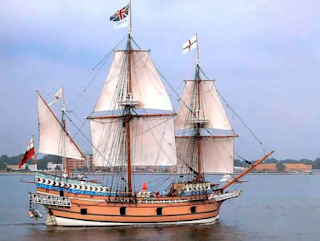On April 26, 1607, at around four o'clock in the morning, three ships that had long been sailing the oceans - the "Susan Constant" and her consorts, the "Godspeed" and the "Discovery" - finally landed at Jamestown. A few days earlier, they had arrived at a cape on the south side of the entrance to the Chesapeake Bay.
About 20 of the 54 men aboard went ashore, led by Captain Christopher Newport, who named the land "Cape Henry" in honor of the Prince of Wales. The party then ventured to the north and named the land "Cape Charles" in honor of the Duke of York.
Their diaries and letters recorded that the land was of "faire meaddowes and goodly tall trees, with fresh-waters running through the woods."
 |
| The Susan Constant |
The three ships sailed up the great river from Cape Henry and the next day they founded the land that Captain Newport named Jamestown in honor of King James I.
It was decided that Jamestown was a better place to disembark and establish their settlement. That very day, Reverend Robert Hunt held the first Church Service in the "New World."
Diaries recorded that the land jutted out "on an extended plaine, a spot of earth which thrust out into depth and midst of the channell."
Thirteen years before the Pilgrims landed at what became know as Plymouth, Massachusetts, the three passenger ships traveled under the direction of the Virginia Company loaded with a group of settlers, all men, most of whom were in search of gold to make their fortune in the New World.
Today in 2019, the replica of the 17th century ship, "the Susan Constant," was built in 1991 by the Jamestown-Yorktown Foundation and financed by the Commonwealth of Virginia at a cost of $2.1 million. Manned by a crew of 25, when not cruising the waters of the Chesapeake Bay, the ship stands on exhibit at the Jamestown Settlement in Virginia, alongside the replicas of the "Godspeed" and the "Discovery. "
The original Susan Constant was built in 1605 in London, weighed 120 tons and was estimated at 116 feet from tip to stern. The ship was used primarily as a freighter for transporting goods. However, for her 1606-1607 voyage, she was leased to the Virginia Company by the English firm of Dapper, Wheatley, Colthurst and Company.
The voyage was staffed by all men and set out to sea on December 20, 1606, lasting four and one-half months and arriving at Jamestown on April 26, 1607. For the first six weeks, the three ships floated side by side in the English Channel waiting for the right winds to carry them on their voyage.
The Susan Constant carried 54 men, the second ship carried the remaining 51 men and the third ship transported all their belongings. Colonist John Smith was one of the 105 men.
A passenger, The Reverend Samuel Purchas, wrote a manuscript in 1625 called "Pilgrims" in which he stated the name of the ship as the "Sarah Constant." But researchers and genealogists believed he was mistaken given that nearly twenty years had passed and that he was confused. Centuries later, looking over the leasing company documents, many newspaper reporters as well as some of the writings of the first settlers said that the ship was always the "Susan Constant" or "Susan."
Though Reverend Samuel Purchas stood firm by his manuscript, no record of a ship named the "Sarah Constant" was ever found for that time period.
The Susan Constant did not stay long in Virginia. As soon as she was filled with timber, she sailed back to England abut she never returned to Virginia again.
Sources:
National Museum of American History, Jamestown-Yorktown Foundation.
No comments:
Post a Comment
Thanks for stopping by. If you like our blog, please give your friends our link so they can come here to enjoy reading our stories too.
https://way-back-in-time.blogspot.com